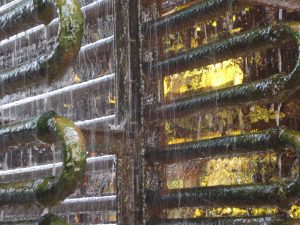The cooling water, or rather the microbiological values of cooling water, have come into the focus of the authorities. For instance in Germany the 42nd edition of the Federal Emissions Ordinance regulates exactly how to deal with Legionella in cooling water. In detail it is about the risk in evaporative cooling systems. In other words, in cooling towers in open cooling systems. In many countries there are either local regulations or regulations from, for example the European Community.
What do algae in cooling water have to do with Legionella?

What to do against algae growth in the cooling water?
The regulations (VDI 2047 part 2) say from a bacterial count of 1000 CFU/100ml a biocide shock dosing should be carried out. Not only does that sound expensive, it is. In the case of larger cooling towers, a shock dosing can easily cost several hundred euros.
A Swabian housewife or a Scottish guy (both know to keep their money tight togehter) would try everything to prevent Legionella in higher concentrations in the cooling water. So working on the cause rather than just treating symptoms.
Merus reduces the growth of algae
As has been proven in many cases, algae do not feel comfortable in water treated by Meru’s rings. They reproduce less quickly and turn brown faster. The brown algae fall to the ground and collect at the bottom in the sump of the cooling tower. If the total number of algae is lower, the Bioflim gets less food in the cooling water. So this also makes it weaker. And is gradually dissolved by the Merus rings. If no biofilm is left in the system, it will also be very difficult for the legionella to reproduce.
